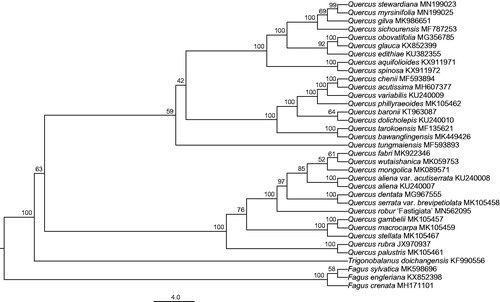Abstract
Quercus stewardiana A.Camus is an East Asian evergreen oak tree species belonging to Quercus section Cyclobalanopsis. In this study, we assembled and annotated the complete chloroplast (cp) genome of the species. The circular genome is 160,842 bp in size, presenting a typical quadripartite structure including two copies of inverted repeat (IR) regions (25,823 bp), one large single-copy (LSC) region (90,294 bp), and one small single-copy (SSC) region (18,902 bp). It encodes a total of 114 unique genes, including 80 protein-coding genes, 30 tRNA genes, and four rRNA genes. Phylogenetic analysis based on cp genome sequences of 35 Fagaceae species indicated that Q. stewardiana was more closely related to Q. myrsinifolia.
Quercus stewardiana A.Camus is an East Asian evergreen oak tree species belonging to the single-celled trichome base (STB) lineage of Quercus section Cyclobalanopsis (Deng et al. Citation2018). It is native to China where it occurs widely across Anhui, Zhejiang, Jiangxi, Hubei, Hunan, Guangdong, Guangxi, Guizhou, Sichuan, and Yunnan Provinces. In the western part of its distribution, Q. stewardiana can coexist with multiple evergreen oak species (e.g., Q. ciliaris C.C.Huang & Y.T.Chang, and Q. sessilifolia Blume) in the mixed mesophytic forests on mountain tops and slopes, with an altitude range of 1,000–2,000 m. A recent phylogenomic study has showed that these species are closely related to each other, and constitute the Acuta clade of section Cyclobalanopsis (Deng et al. Citation2018). In this study, we sequenced, assembled, and annotated the complete chloroplast (cp) genome of Q. stewardiana to provide more useful genomic resources for the future studies on the phylogeny of ring-cupped oaks.
Fresh leaves were sampled from a wild individual near the Ciguang Pavilion in the Mountain Huangshan Scenic Area, Anhui Province, China (30°6′24.56″N, 118°10′3.48″E, 813 m). The voucher specimen was deposited at the Herbarium of Nanjing Forestry University (accession number YL20190417001). Total genomic DNA was extracted following Li et al. (Citation2019). Whole genome sequencing was conducted by Nanjing Genepioneer Biotechnologies Inc. (Nanjing, China) on the Illumina Hiseq X Ten platform. A total of 29,152,346 clean reads were produced and used for the de novo assembly with NOVOplasty 2.7.2 (Dierckxsens et al. Citation2016). Gene annotation was performed using the CpGAVAS pipeline (Liu et al. Citation2012).
The complete plastid genome of Q. stewardiana (GenBank accession number MN199023) is a circular molecule of 160,842 bp in length. It has a typical quadripartite structure including one large single-copy (LSC) region (90,294 bp), one small single-copy (SSC) region (18,902 bp), and two copies of inverted repeat (IR) regions (25,823 bp). The overall GC content was 36.89%, while the corresponding values of the LSC, SSC, and IR regions were 34.74%, 31.09%, and 42.78%, respectively. A total of 133 genes were encoded, of which 114 were unique and 19 were duplicated in the IR regions. Among the unique genes, 80 were protein-coding genes, 30 were tRNA genes, and four were rRNA genes. Nine protein-coding genes and six tRNA genes contained one intron, and other three genes (rps12, ycf3, clpP) contained two introns.
A maximum-likelihood (ML) tree of 35 Fagaceae species was reconstructed to identify the phylogenetic position of Q. stewardiana. Species from Trigonobalanus and Fagus were selected as outgroups. Four locally collinear blocks were identified and a matrix of 92,127 bp was generated by the HomBlocks pipeline (Bi et al. Citation2018). The ML analyses were performed with raxmlGUI 1.5 (Silvestro and Michalak Citation2012) under the GTRGAMMA substitution model. Node support was assessed using 1,000 fast bootstrap replicates. Our results indicated that Q. stewardiana was more closely related to Q. myrsinifolia with 100% bootstrap support ().
Figure 1. The maximum-likelihood (ML) phylogenetic tree reconstructed by raxmlGUI 1.5 (Silvestro and Michalak Citation2012) based on cp genome sequences of 35 Fagaceae species. The bootstrap support value is labeled for each node.

Acknowledgments
The authors thank Jun Wu and Mingxia Tang from the Garden Bureau, Mount Huangshan Scenic Area Management Committee for their help with fieldwork; Cheng Zhang from Nanjing Forestry University for his assistant with data analysis.
Disclosure statement
No potential conflict of interest was reported by the author(s).
Data availability
The complete chloroplast genome sequence of Quercus stewardiana is deposited in the GenBank database under the accession number MN199023.
Additional information
Funding
References
- Bi G, Mao Y, Xing Q, Cao M. 2018. HomBlocks: a multiple-alignment construction pipeline for organelle phylogenomics based on locally collinear block searching. Genomics. 110(1):18–22.
- Deng M, Jiang XL, Hipp AL, Manos PS, Hahn M. 2018. Phylogeny and biogeography of East Asian evergreen oaks (Quercus section Cyclobalanopsis; Fagaceae): insights into the Cenozoic history of evergreen broad-leaved forests in subtropical Asia. Mol Phylogenet Evol. 119:170–181.
- Dierckxsens N, Mardulyn P, Smits G. 2016. NOVOPlasty: de novo assembly of organelle genomes from whole genome data. Nucleic Acids Res. 45:18.
- Li Y, Wang L, Fang Y. 2019. The complete chloroplast genome sequence of Quercus myrsinifolia (Fagaceae). Mitochondrial DNA B. 4(2):3139–3140.
- Liu C, Shi L, Zhu Y, Chen H, Zhang J, Lin X, Guan X. 2012. CpGAVAS, an integrated web server for the annotation, visualization, analysis, and GenBank submission of completely sequenced chloroplast genome sequences. BMC Genomics. 13:715.
- Silvestro D, Michalak I. 2012. raxmlGUI: a graphical front-end for RAxML. Org Divers Evol. 12(4):335–337.
